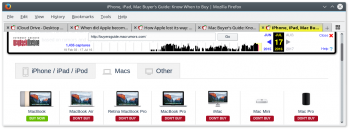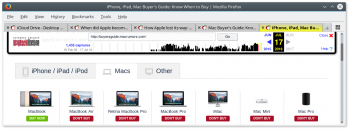I too lament the loss of the 17" MacBook Pro. I think that the 13" and 15" are the ones they are focussing on to capture more of the education market. I know that the 13" MacBook Pro is the singularly most popular laptop amongst my college friends. Heck, I am typing on one at this very moment!
I get the feeling that the 17" was being bought primarily as a desktop-replacement computer, or used by people who did presentations and wanted the larger screen so that they could look at that, rather than turning to see the projected slides.
I am still waiting on a replacement graphics card for the G5 that I purchased for practically nothing off eBay. I'll see about getting 10.4 or 10.5 running on it, or maybe even a distribution of Linux. I think it may be hard to go back to those older versions of OSX, as I have become accustomed to a few features only found in Yosemite and El Capitan.
I think that Apple made a big mistake going to the "trash-can" form factor for the Mac Pro, which is why the 5,1 (2010-2012) is still in use and very hard to get hold of second-hand, despite being manufactured for three years! The new form factor has forced people to upgrade to external hardware, whereas with the classic Mac Pro, you could add what you needed internally and then forget about it.
My own Mac Pro is an older 3,1 from 2008. This one has the easiest CPU upgrade. The later versions used uncapped CPUs and used the heatsink as the retaining mechanism for the CPUs. Apparently, not getting the proper even tension on the heatsink mounting screws is the cause of a lot of problems when upgrading the CPUs in the 4,1 and 5,1 models.
I think that my 2003 G5 PowerMac will still be useful. It was dirt cheap anyway. It might not be a high-end machine any more, but I think I can put it to pasture as a general purpose desktop machine, which is realistically 90% of all personal computer use these days.
I think that Apple started to become boring about 2012/2013 after Steve Jobs passed away. I don't know how much influence Steve had on R&D, creating new styles of product, but I think that his strength was that he was able to get a good sense of what the market wanted even if the market didn't know exactly what it wanted.
I noticed that it was around that same time that Apple's products suddenly began to be non user-upgradable. The 2011 and 2012 MacBook Pros (non-Retina) were very easy to upgrade with more RAM and a different HDD or even an SSD. I put 16GB of RAM in mine and a 240GB SSD, and this 5-year old computer flies along almost as fast as the newest models. The old Mac Pros were upgradable and customisable too. The HDD sleds were a stroke of genius. My Mac Pro will be getting an SSD upgrade later this year, more RAM and two new CPUs.
Apple seems to be heading down the path of proprietary sealed black-boxes with a black-widow spider inside, which are designed to be obsolete within 5 years. I think that it is a credit to Apple's older design teams which made products which can still be upgraded and are perfectly usable several years after their original date on manufacture and can still run all current software. How many people out there are still using PCs from 2008?
I get the feeling that the 17" was being bought primarily as a desktop-replacement computer, or used by people who did presentations and wanted the larger screen so that they could look at that, rather than turning to see the projected slides.
I am still waiting on a replacement graphics card for the G5 that I purchased for practically nothing off eBay. I'll see about getting 10.4 or 10.5 running on it, or maybe even a distribution of Linux. I think it may be hard to go back to those older versions of OSX, as I have become accustomed to a few features only found in Yosemite and El Capitan.
I think that Apple made a big mistake going to the "trash-can" form factor for the Mac Pro, which is why the 5,1 (2010-2012) is still in use and very hard to get hold of second-hand, despite being manufactured for three years! The new form factor has forced people to upgrade to external hardware, whereas with the classic Mac Pro, you could add what you needed internally and then forget about it.
My own Mac Pro is an older 3,1 from 2008. This one has the easiest CPU upgrade. The later versions used uncapped CPUs and used the heatsink as the retaining mechanism for the CPUs. Apparently, not getting the proper even tension on the heatsink mounting screws is the cause of a lot of problems when upgrading the CPUs in the 4,1 and 5,1 models.
I think that my 2003 G5 PowerMac will still be useful. It was dirt cheap anyway. It might not be a high-end machine any more, but I think I can put it to pasture as a general purpose desktop machine, which is realistically 90% of all personal computer use these days.
I think that Apple started to become boring about 2012/2013 after Steve Jobs passed away. I don't know how much influence Steve had on R&D, creating new styles of product, but I think that his strength was that he was able to get a good sense of what the market wanted even if the market didn't know exactly what it wanted.
I noticed that it was around that same time that Apple's products suddenly began to be non user-upgradable. The 2011 and 2012 MacBook Pros (non-Retina) were very easy to upgrade with more RAM and a different HDD or even an SSD. I put 16GB of RAM in mine and a 240GB SSD, and this 5-year old computer flies along almost as fast as the newest models. The old Mac Pros were upgradable and customisable too. The HDD sleds were a stroke of genius. My Mac Pro will be getting an SSD upgrade later this year, more RAM and two new CPUs.
Apple seems to be heading down the path of proprietary sealed black-boxes with a black-widow spider inside, which are designed to be obsolete within 5 years. I think that it is a credit to Apple's older design teams which made products which can still be upgraded and are perfectly usable several years after their original date on manufacture and can still run all current software. How many people out there are still using PCs from 2008?
Last edited:



